Gondar: This is my culture
"Please...can you help...me?"
Dumbly, I stared into the girl's concerned eyes. She repeated, "please, can you help me?"
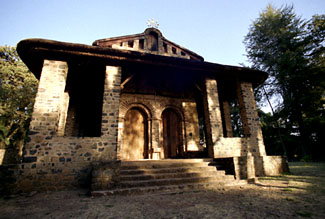 |
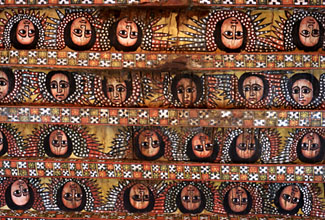 Cherub ceiling of Debre Birhan Selassie. |
Following some hurried discussion in Amharic with her sister, she revised her question: "Can I help you?"
Ahh. I'd end up hearing this mix-up a few times throughout the trip.
After spending too much time relaxing in my room, I was in a rush to see Debre Birhan Selassie church in the last bit of afternoon sun. Along the winding hill road were startled children ("CHEEEENA!"), livestock, and oddly, a couple women with baboons on leashes. They didn't seem to be aiming for tourist dollars as much as taking their pets for a walk. Lining the route were wooden sheds operating as convenience shops.
The adorable children living near the church invited me to visit, but I needed to at least peek in at the church while it was still open. While Debre Birhan Selassie's justly famous cherub-covered ceiling was as delightful as expected and the knowledgable guide I was gently guilted into taking—"what is 20 birr to you?"—spoke perfect English, I couldn't keep my mind from wandering to the sweet family waiting for me outside.
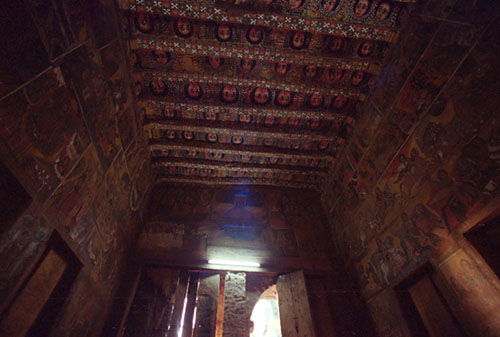
Inside view of Debre Birhan Selassie and its murals.
Now I sat in the house with two young women who wanted to practice their limited English and teach me Amharic, while the 18-year-old who first welcomed me bustled in the kitchen.
Young Kidist, who pronounced her name with a click I could not replicate, graciously brought out injera and a particularly thick and mild shiro wat, then busied herself preparing the coffee ceremony. Her sister Lamhat and their friend Adam worked together, while the charming kids belonged to another sister who shyly hung back, speaking no English at all. An ancient skeletal woman was introduced as "mother," although whether she was actually the grandmother or simply prematurely antique was difficult to ascertain.
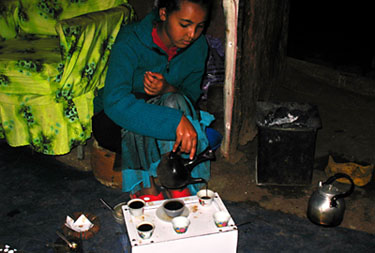 Kidist pours the coffee |
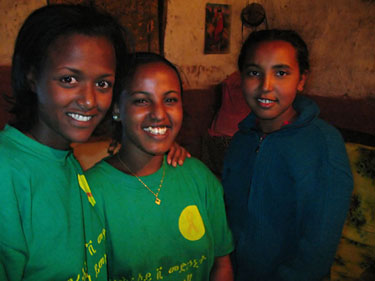 Adam, Lamhat, Kidist |
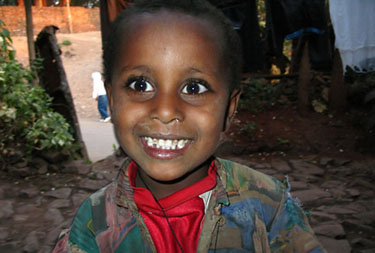 |
Adam took great pleasure in scooping copious quantities of food directly into my mouth; her enormous eyes growing larger with amusement as I tried to hold it all in. Gursha, the act of feeding dear friends by hand, breaks down personal barriers and can be viewed as a gesture of trust. With every morsel she exclaimed, "my love!" Due to my surprise and laughter, Adam continued to feed me until she could see I'd had enough, then took that opportunity to teach me to say "beka!"
Through creative gestures, I conveyed that I worked in fashion design, as usual feeling self-conscious that this was not evident in my traveling clothes. No matter, both Adam and Kidist were thrilled, as both were very interested in the field themselves.
Watching us silently from the wall throughout the coffee ceremony, the small children eventually offered their first timid "ferengi?" to which I playfully answered "habesha!" (Ethiopian) and thoroughly confused them; the wizened old mother came to life with a hearty laugh.
Caffeine-fueled, the girls decided to teach me another Ethiopian tradition. Putting on some music, Kidist skillfully displayed the shuddering shoulder rolls typical of eskesta, or "shoulder dance." Beseeching, "please...this is my culture!" Kidist convinced me to try my best approximation. Unfortunately, I do not possess the ability to detach my shoulders from the rest of my body.
Continuing the lesson, Kidist haltingly informed me that her family was Tigrai, and had their own twist on shoulder-dancing, with jutting side-to-side head motions that I gamely imitated while the rest of the family gasped with laughter.
Hours passed before I took my leave from this warm family. It was dark out, so the girls walked me back to town. About halfway down the hill, Kidist turned back and kissed me goodbye. Several minutes later we arrived at Adam's house.
Adam had a huge family, many young brothers and sisters. Her older sister spoke beautiful English. Startlingly slim, even for an Ethiopian, she worked as an accountant and had perfected her English skills in college. As much as I'd adored communicating with Lamhat, Kidist and Adam through gestures, it was a relief to meet someone who could translate.
Lamhat headed back to her house after kissing me goodbye. Adam and her sister walked me to the flat tree-lined road behind the Administrative Buildings until the sister said awkwardly, "I think this is enough." Adam's final question, translated through her sister: how to get into the fashion industry here in Ethiopia? I had no answer: Ethiopia does not have much of a textile industry, let alone fashion. I told her sister that she might have better luck in Egypt or South Africa, otherwise she might have to start her own business. It probably wasn't a good answer.
With their phone numbers in hand—yet how could I call people who don't speak English?—I reluctantly bid them farewell, grateful I'd come to Gondar if for no other reason but this meeting.